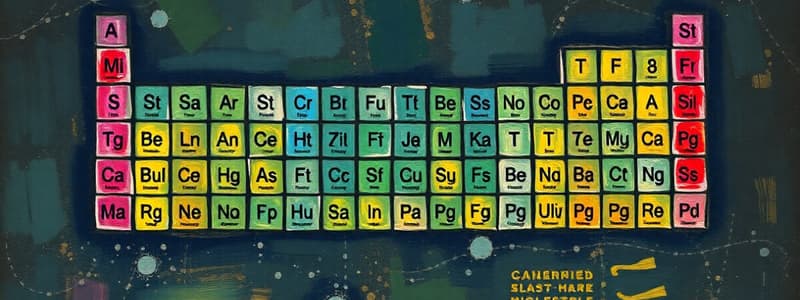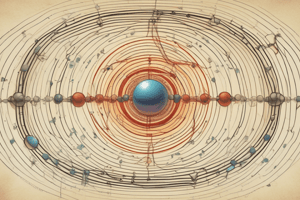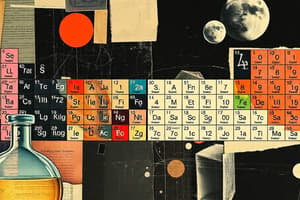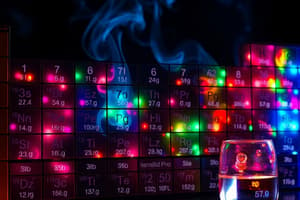Podcast
Questions and Answers
There are ______ naturally occurring elements.
There are ______ naturally occurring elements.
92
The ______ is the lightest element on the periodic table.
The ______ is the lightest element on the periodic table.
hydrogen
Elements are arranged in order of ______.
Elements are arranged in order of ______.
atomic mass
Atoms with a small ionization energy tend to ______ electrons.
Atoms with a small ionization energy tend to ______ electrons.
Electron affinity is the energy released when an atom ______ an electron.
Electron affinity is the energy released when an atom ______ an electron.
Non-metals tend to gain electrons, resulting in a high ______.
Non-metals tend to gain electrons, resulting in a high ______.
Ionization energy increases as you move across a ______.
Ionization energy increases as you move across a ______.
Group 7 elements have the highest electron ______.
Group 7 elements have the highest electron ______.
Flashcards
Ionization Energy
Ionization Energy
The measure of energy required to remove one electron from an atom in its gaseous state.
Electron Affinity
Electron Affinity
The energy change that occurs when an electron is added to a neutral atom in its gaseous state.
Periodic Table
Periodic Table
Elements arranged in order of increasing atomic number, with elements having similar properties in the same vertical columns.
Groups
Groups
Signup and view all the flashcards
Periods
Periods
Signup and view all the flashcards
Atomic Number
Atomic Number
Signup and view all the flashcards
Relative Atomic Mass
Relative Atomic Mass
Signup and view all the flashcards
Periodic Table Blocks (s, p, d, and f)
Periodic Table Blocks (s, p, d, and f)
Signup and view all the flashcards
Study Notes
The Periodic Table
- There are 92 naturally occurring elements.
- Elements are arranged in order of increasing atomic number, not just atomic mass. Hydrogen is the lightest. Heavier elements are not necessarily towards the right.
- About three-quarters of the elements are metals.
- Elements are grouped together because they have similar properties.
- The large number next to each element is the relative atomic mass.
- The small number next to each element is the atomic number, which is the number of protons in the atom.
- Groups are vertical columns and periods are horizontal rows.
- The first 20 elements are worth learning by-heart.
- The periodic table is divided into blocks: s, p, d, and f. These blocks are associated with the subshells of electrons.
Ionization Energy
- Ionization energy is the energy required to remove one electron from an atom.
- Atoms with a small ionization energy tend to lose electrons.
- Atoms with a large ionization energy tend to hold onto their electrons.
- Atoms want to have a full outer shell of electrons.
- Atoms with one or two electrons in their outer shell tend to lose these electrons.
- Atoms with nearly a full outer shell tend to gain electrons.
- Ionization energy increases as you move across a period (from left to right) due to an increase in the number of protons in the nucleus, which attracts electrons more strongly.
- Ionization energy decreases as you move down a group because the electrons are further from the nucleus, making them easier to remove.
Electron Affinity
- Electron affinity is the energy released when an atom gains an electron.
- Atoms that want to gain electrons have a high electron affinity.
- Metals tend to lose electrons, so they do not have a high electron affinity.
- Non-metals tend to gain electrons, so they have a high electron affinity.
- Group 7 elements (fluorine, chlorine, bromine, iodine) have the highest electron affinities because they are most likely to gain an electron.
- Electron affinity increases as you move across a period (from left to right) because the atoms are more likely to gain an electron.
- It is more challenging to predict electron affinity trends down a group because the size of the atom plays a role.
Studying That Suits You
Use AI to generate personalized quizzes and flashcards to suit your learning preferences.




